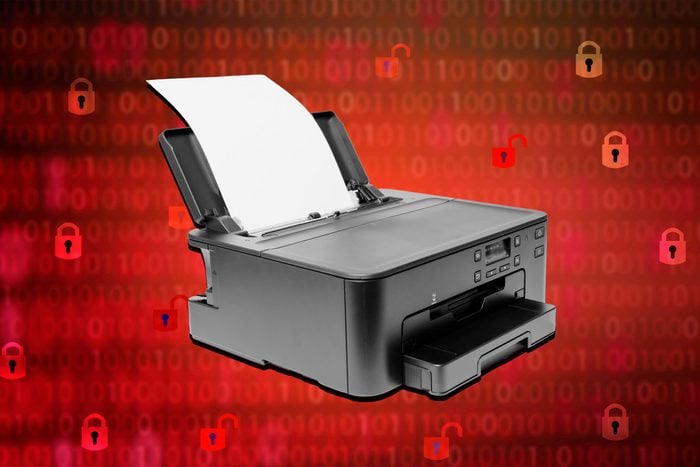Getting Rid of a Printer? Do This First—or Risk Getting Hacked
Updated: Dec. 04, 2023

Knowing how to dispose of a printer safely could mean the difference between protecting your personal data and allowing it to fall into the wrong hands
We’ve all grown savvy to safeguarding our personal data on computers and phones—meticulously encrypting emails, setting up complex passwords and regularly updating our software. But despite our best efforts, there’s a vulnerability we often overlook that could be sitting right on our desks: the humble printer. Believe it or not, figuring out how to dispose of a printer could make or break our online security.
Recently, new revelations about certain printers shed light on the unforeseen security risks that could be lurking in our offices and homes. But with the following tech tips from cybersecurity experts, you’ll be able to combat the unexpected threat found in many printers and fortify your data against hackers.
Get Reader’s Digest’s Read Up newsletter for more tech tips, travel, cleaning, humor and fun facts all week long.
How can your printer put your personal information at risk?
It boils down to the fact that any digital device that connects to your home Wi-Fi, including your printer, stores data about the network on its hard drive. This is normally a good thing, since it allows the printer to automatically connect to the internet without asking you to re-enter the information every time. When you sell or recycle a printer, you should delete this saved data by performing a memory wipe or factory reset, which prevents cybercriminals from discovering and exploiting the info, according to Chris Pierson, PhD, CEO of the cybersecurity company BlackCloak.
There’s just one problem: Canon recently announced that a security flaw in a handful of its printers leaves behind the stored Wi-Fi information even after the reset process. If a hacker gains access to the printer after you sell it or throw it away, they could find these wireless settings simply by going to the Wi-Fi option in the main menu. Canon’s advisory notes that this issue affects several of its printer models, including the E, G, GX, iB, iP, MB, MG, MX, PRO, TR, TS and XK series.
What type of information is at risk?
Data about your wireless settings—including your Wi-Fi name, Internet Protocol address and the password to the network—could all stick around even after resetting your Canon printer. Once hackers find that information through the menu commands, they could easily log in to your Wi-Fi and spy on your online activity, including sensitive information like your bank account login, credit card numbers and personal photos.
Fortunately, there have been no reports of anyone falling victim to this issue in real life yet. This suggests that Canon got word of this flaw from either a researcher or customer who noticed it, according to Pierson.
Is this a potential problem with all printers?
While the current notice is specific to Canon’s printers, it “serves as a reminder [of the risks] to everyone with any electronic device that connects to a home network,” Pierson says. That includes other Wi-Fi-connected printers, as well as smart devices like your Ring doorbell, refrigerator, dryer and even light bulbs.
In fact, you might be surprised by all the devices in your house that access and store your Wi-Fi settings—and consequently might leave your data vulnerable. “Wi-Fi-connected devices have proliferated, and [they include] things that we may not think of,” says Alex Hamerstone, a director at the security-consulting firm TrustedSec. “A lot of low-priced consumer electronics from previously unknown manufacturers have Wi-Fi access now, and I would be more worried about those.”
That’s why it’s important to know how to dispose of a printer and any electronic device that you plan to donate or discard. “Given that the holiday season is right around the corner, this is a great reminder that when discarding old devices, ensure you wipe or do a factory reset on those devices to mitigate data leakage,” Pierson says.
How to dispose of a printer the right way
Before you throw away, donate or even send in your printer for repair, you should always perform a factory reset to erase all stored information. The specific steps for a factory reset will vary depending on your printer model, but the reset function is typically found under the “General” or “Setup” setting in the main menu.
For Canon printers, follow these steps for a factory reset:
- Go to the Setup option in the main menu.
- Select Device settings > OK, then select Reset settings > OK.
- Find Reset, then choose OK.
- Select Yes to restore the printer to factory settings.
In addition, users who have one of the affected Canon printers should take the following steps to ensure their Wi-Fi data is deleted:
- In the menu, go to Reset settings > Reset all.
- Enable the wireless LAN.
- Follow the first step one more time, going to Reset settings > Reset all.
If you have a Canon printer model that does not have the “Reset all settings” function, do this instead:
- Select Reset LAN settings.
- Enable the wireless LAN.
- Select Reset LAN settings one more time.
What else should you keep in mind about printer safety?
Wiping your Wi-Fi settings isn’t the only step you should take to protect personal information stored on your printer. Aside from learning how to dispose of a printer properly, here are more tips to boost your printer-safety IQ:
- Choose a printer model that offers extra security features, such as built-in encryption, authentication, firewall and firmware update capabilities.
- Adjust your printer’s privacy settings to better protect your information. For example, try disabling or limiting the printer’s network connectivity, such as Wi-Fi, Bluetooth or cloud services, if you don’t need or use those features. You can also disable the printer’s memory or hard drive to erase your data after printing.
- Enable the printer’s password, PIN or biometric authentication to prevent anyone from accessing its data without permission.
- Keep your printer’s software up to date, which will fix bugs and patch any security vulnerabilities that hackers could exploit.
- If you are printing documents with sensitive information like bank or financial data, consider using encryption tools or software, such as BitLocker or VeraCrypt, to encrypt your files before printing.
- Wipe or remove the hard drive on your printer before donating or discarding it.
- Avoid connecting your printer to public Wi-Fi, which could leave it vulnerable to spyware and other security risks.
Now that you know how to dispose of a printer safely, learn the proper steps to take before recycling a smartphone.
About the experts
- Chris Pierson, PhD, is the founder and CEO of BlackCloak, a cybersecurity company.
- Alex Hamerstone is the director of advisory solutions at security-consulting firm TrustedSec.
Sources:



